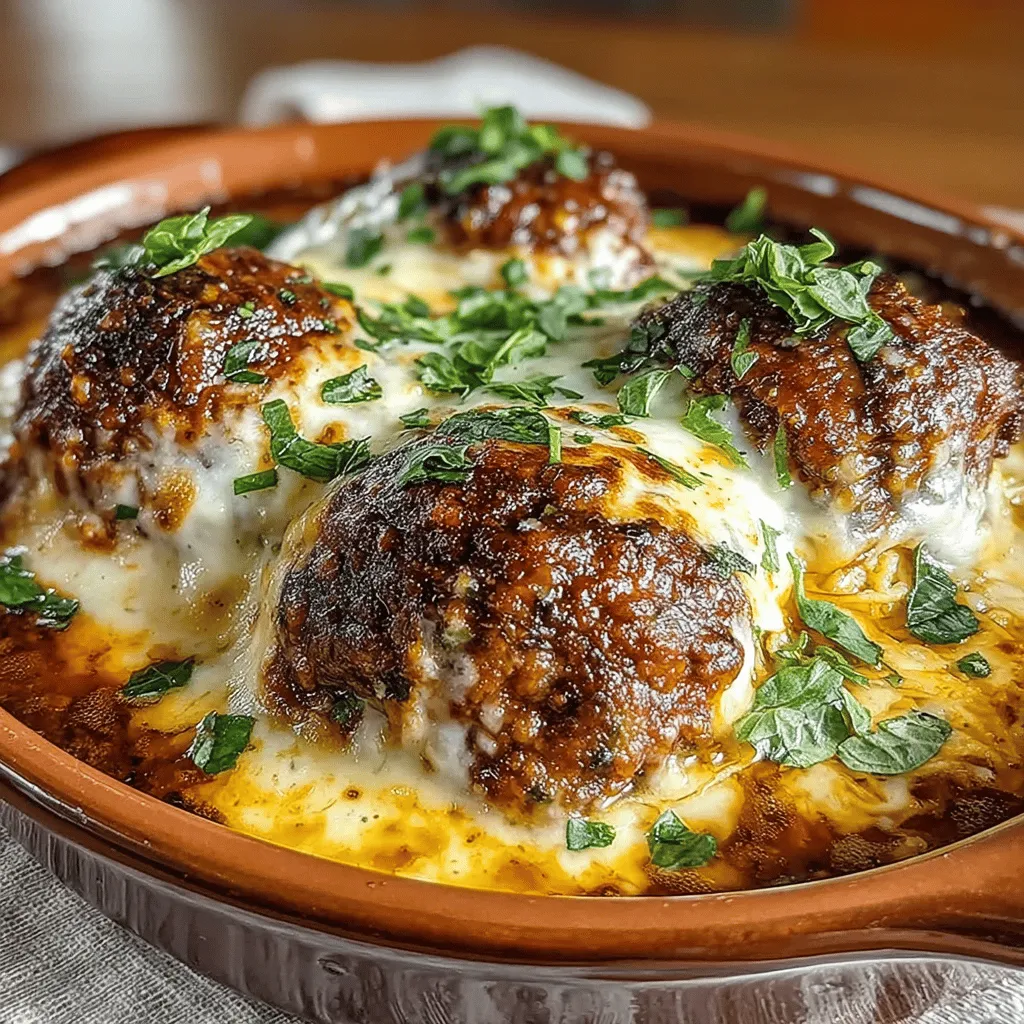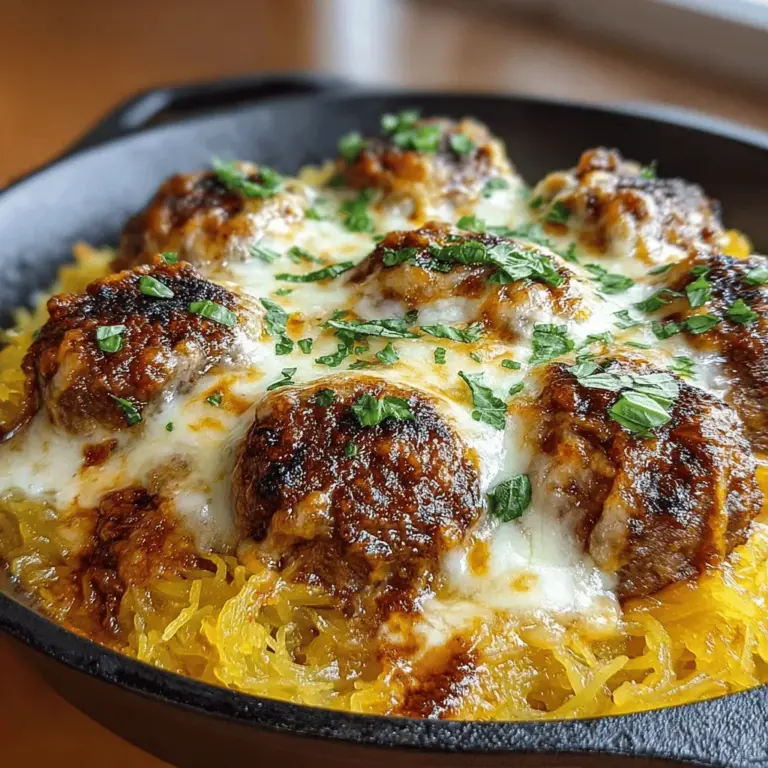Spaghetti Squash & Meatball Bake: A Nutritious Twist on a Classic Favorite
In recent years, there has been a significant shift towards healthier eating habits, particularly when it comes to beloved comfort foods. Traditional pasta dishes, while delicious, often come with a hefty calorie count and carbohydrates that can leave you feeling heavy. As a result, health-conscious eaters are increasingly turning to innovative alternatives that not only satisfy cravings but also support their wellness goals. One such alternative is spaghetti squash, a nutrient-dense vegetable that has garnered attention for its versatility and ability to mimic the texture of pasta.
Spaghetti squash serves as a fantastic foundation for a variety of dishes, and when paired with meatballs, it creates a comforting and wholesome meal that the whole family can enjoy. The combination of tender, roasted squash and savory meatballs baked together in a warm, cheesy casserole is a delightful way to indulge without the guilt. This Spaghetti Squash & Meatball Bake is not only a crowd-pleaser but also a great option for those looking to incorporate more vegetables into their diet while still enjoying traditional flavors.
Understanding Spaghetti Squash
At first glance, spaghetti squash may appear unassuming, but its unique characteristics make it a standout ingredient in the realm of healthy cooking. This winter squash is oval-shaped, with a yellow or cream-colored skin, and it boasts a plethora of health benefits. Spaghetti squash is low in calories—one cup contains approximately 42 calories—making it an excellent choice for those watching their caloric intake. Additionally, it is an excellent source of vitamins A and C, as well as fiber, which promotes digestive health.
When compared to traditional pasta, spaghetti squash holds a significant advantage: it contains much fewer carbohydrates. This makes it an ideal option for those following low-carb or ketogenic diets. When cooked, the flesh of the squash separates into strands that resemble spaghetti, hence its name. This texture allows it to serve as a perfect substitute for pasta in a variety of dishes, from marinara to creamy Alfredo.
Cooking spaghetti squash can be accomplished in several ways, each yielding delicious results. The most common methods are baking and microwaving. Baking the squash enhances its natural sweetness and creates a tender texture, while microwaving is a quicker option that still produces satisfying results. Regardless of the method you choose, the key is to ensure the squash is adequately cooked to facilitate easy shredding of the flesh into spaghetti-like strands.
The Allure of Meatballs
No dish featuring spaghetti would be complete without the iconic meatball. Meatballs have a rich history and cultural significance in many cuisines around the world, from Italian to Swedish, and beyond. They are often associated with comfort food, evoking memories of family gatherings and hearty meals. The beauty of meatballs lies in their adaptability; they can be made from a variety of ground meats or even plant-based alternatives, catering to diverse dietary preferences.
When it comes to choosing the type of meat for your meatballs, ground beef and turkey are popular options. Beef meatballs tend to be richer in flavor and have a higher fat content, which contributes to their juiciness. On the other hand, turkey meatballs are a leaner alternative, offering a lighter option without sacrificing taste. It’s also worth noting that meatballs can be made vegetarian or vegan by using ingredients such as lentils, beans, or plant-based meat substitutes, making this dish accessible to a wider audience.
The success of meatballs often hinges on the right blend of seasonings and binding agents. Herbs and spices like garlic, onion powder, and oregano can elevate the flavor profile, while breadcrumbs or almond flour help maintain their shape and texture during cooking. The careful balance of these elements is essential for creating a delicious meatball that complements the spaghetti squash perfectly.
Ingredients Breakdown
Before diving into the cooking process, it’s important to understand each ingredient that will contribute to the deliciousness of the Spaghetti Squash & Meatball Bake.
1. Spaghetti Squash: Selecting the right spaghetti squash is crucial for achieving the best flavor and texture. Look for a squash that is firm, with a smooth, unblemished skin. Once you have your squash, preparation is key. Start by cutting it in half lengthwise and removing the seeds. This will allow for even cooking and make it easier to shred the flesh into strands.
2. Ground Meat Options: The choice of ground meat can significantly impact the dish’s flavor and texture. Ground beef is a classic choice, rich and flavorful, while ground turkey offers a lighter alternative that still packs a punch. If you’re looking for a healthier option, consider using lean turkey or even ground chicken.
3. Breadcrumbs vs. Almond Flour: When it comes to binding the meatballs, traditional breadcrumbs can be swapped for almond flour to create a gluten-free version. Almond flour not only adds a nutty flavor but also enhances the moisture of the meatballs.
4. Cheeses: Parmesan and mozzarella cheese play vital roles in this dish. Parmesan adds a sharp, salty flavor that enhances the meatballs, while mozzarella contributes creaminess and a gooey texture when melted. Both cheeses are essential for achieving that comforting, baked goodness.
5. Fresh Herbs: Finally, the addition of fresh herbs like basil not only elevates the dish’s flavor but also adds a pop of color. Herbs can brighten the overall taste and provide a fresh contrast to the rich flavors of the meatballs and cheese.
Step-by-Step Cooking Instructions
Cooking the Spaghetti Squash
The first step in creating this delectable dish is cooking the spaghetti squash. Preheat your oven to 400°F (200°C). While the oven heats, carefully slice the spaghetti squash in half lengthwise, using a sharp knife. Once halved, scoop out the seeds and discard them. Drizzle the inside of the squash with olive oil and a sprinkle of salt and pepper for enhanced flavor.
Place the squash halves cut side down on a baking sheet lined with parchment paper. This method helps to steam the squash, ensuring it cooks evenly and becomes tender. Bake the squash in the preheated oven for about 30 to 40 minutes, depending on its size. You’ll know it’s ready when the flesh is easily pierced with a fork and can be shredded into spaghetti-like strands.
Once cooked, remove the squash from the oven and let it cool slightly before using a fork to scrape the insides. This will yield the beautiful strands that will serve as your healthy pasta base.
In the next part of the article, we will delve into crafting the perfect meatballs and assembling the Spaghetti Squash & Meatball Bake for a delightful family meal. Stay tuned for the step-by-step cooking instructions and tips for achieving the best results!

Tips on How to Scrape the Squash into Noodles Effectively
Scraping spaghetti squash into noodles can seem daunting, but with the right technique, it can be a breeze. Once your squash is roasted and cool enough to handle, take a fork and start at the center, pulling the strands towards you. The key is to use a gentle motion; if you dig too hard, you may end up with mush instead of perfectly formed noodles. Continue this process until you’ve scraped out all the flesh, which should yield an impressive bowl of spaghetti-like strands.
For an added flavor dimension, consider sprinkling the freshly scraped squash with a little salt and pepper, or a drizzle of olive oil to enhance its natural sweetness. This will elevate the overall flavor of your dish.
Making the Meatballs
Step-by-Step Guidance on Mixing Ingredients Without Overworking the Meat
Creating the perfect meatball is about balance—keeping the meat tender while ensuring it holds together. Start by choosing your ground meat—beef, turkey, or a mix of both works well. In a large mixing bowl, combine the ground meat with breadcrumbs, finely chopped onions, minced garlic, egg, fresh herbs like parsley or basil, and your favorite seasonings.
To mix without overworking the meat, use a fork or your hands to gently combine the ingredients until just incorporated. Overmixing can lead to tough meatballs, so aim for a homogenous mixture without excessive handling.
Tips on Forming Uniform Meatballs for Even Cooking
When it comes to forming meatballs, consistency is key. Using a small ice cream scoop or a tablespoon can help you achieve uniform sizes, ensuring even cooking throughout. Roll each ball gently between your palms to create a neat shape, but avoid compressing them too tightly. A softer meatball will yield a juicier texture after cooking.
Cooking the Meatballs
Insights on Achieving the Perfect Browning and Texture
For optimal flavor and texture, browning the meatballs before baking is essential. Heat a large skillet over medium-high heat and add a splash of olive oil. Once hot, carefully place your meatballs in the skillet. Avoid overcrowding, as this will cause steaming rather than browning. Cook for about 3-4 minutes on each side, rotating them until they are evenly browned all over. This step locks in the flavors and adds a delightful crust.
Discussing the Significance of Skillet Cooking Versus Baking
While you could bake the meatballs directly in the oven, skillet cooking adds an extra layer of flavor through caramelization. The browned bits that form in the skillet can also be deglazed with a splash of broth or wine, creating a simple sauce that can be drizzled over the assembled bake. This method not only enhances the meatballs but also contributes to the overall flavor profile of your dish.
Assembling the Bake
Detailed Layering Instructions for Optimal Flavor Distribution
Now that you have your spaghetti squash and meatballs ready, it’s time to assemble your bake. Start by spreading half of the spaghetti squash evenly across the bottom of a greased baking dish. Next, layer half of your meatballs on top, followed by a generous amount of marinara sauce. Repeat with the remaining squash and meatballs, finishing with a final layer of sauce.
Explanation of How Each Layer Contributes to the Final Dish
Each layer in this bake serves a purpose: the squash provides a nutritious base, the meatballs add protein, and the marinara sauce contributes moisture and flavor. Topping the final layer with shredded mozzarella cheese will create a bubbly, golden crust that is both inviting and delicious. This layering technique not only enhances the taste but also ensures that every bite is a harmonious blend of flavors.
Baking Process
Importance of Covering with Foil Initially and Then Uncovering for Browning
Preheat your oven to 375°F (190°C). Cover the baking dish with aluminum foil to trap steam and ensure that the meatballs cook through without drying out. Bake for about 25 minutes, then remove the foil and continue baking for an additional 10-15 minutes or until the cheese is melted and bubbly. This two-step process allows for both thorough cooking and a beautifully browned top.
Indicators for Doneness and the Importance of Cheese Texture
To check for doneness, ensure that the internal temperature of the meatballs reaches 165°F (74°C). The cheese should be melted and slightly golden, indicating a deliciously crispy top. Allow the dish to cool for a few minutes before serving, which will make it easier to slice and serve.
Serving Suggestions
Ideas for Side Dishes that Complement the Spaghetti Squash and Meatball Bake
This spaghetti squash and meatball bake is hearty enough to stand alone, but pairing it with a crispy side salad or steamed vegetables enhances the meal’s nutritional profile. A simple arugula salad with lemon vinaigrette or roasted broccoli would provide a fresh contrast to the rich flavors of the bake.
Suggestions for Presenting the Dish to Enhance Its Visual Appeal
Presentation matters, especially for a dish as visually appealing as this one. Serve the bake in the baking dish for a rustic look, or transfer individual portions to colorful plates. Garnish with freshly chopped herbs like basil or parsley to add a pop of color. A sprinkle of grated Parmesan cheese on top just before serving can elevate the dish further.
Nutritional Benefits of the Dish
Breakdown of Calories, Protein, and Other Nutritional Aspects per Serving
This spaghetti squash and meatball bake is not only delicious but also nutritious. A typical serving contains approximately 350-400 calories, depending on the specific ingredients used. It provides a good balance of macronutrients, with about 30 grams of protein, 15 grams of carbohydrates, and 20 grams of healthy fats.
Discussion on How This Dish Fits into Various Dietary Lifestyles
This dish is an excellent option for various dietary lifestyles, including low-carb and gluten-free. The spaghetti squash serves as a fantastic alternative to traditional pasta, significantly reducing carbohydrate intake while still providing a satisfying texture. The use of lean meats and fresh vegetables makes it a wholesome choice for anyone looking to incorporate more nutritious meals into their diet.
Benefits of Incorporating More Vegetables into Meals for Overall Health
Eating more vegetables, such as spaghetti squash, can lead to improved health outcomes. They are rich in vitamins, minerals, and fiber, which can aid digestion and promote a feeling of fullness. Regularly incorporating vegetables into meals can help maintain a healthy weight and reduce the risk of chronic diseases.
Conclusion
This spaghetti squash and meatball bake is not only a delicious meal but also a wholesome and comforting option for families. Its combination of flavors and textures makes it a crowd-pleaser, while its nutritional benefits cater to those seeking healthier alternatives without sacrificing taste.
We encourage you to explore variations of this recipe to suit your personal tastes—try different meats, sauces, or even add vegetables like spinach or bell peppers for extra nutrition. Embrace the joy of healthy eating while enjoying the rich flavors of this delightful bake. With each bite, you’ll be reminded that nutritious meals can be both satisfying and flavorful!

